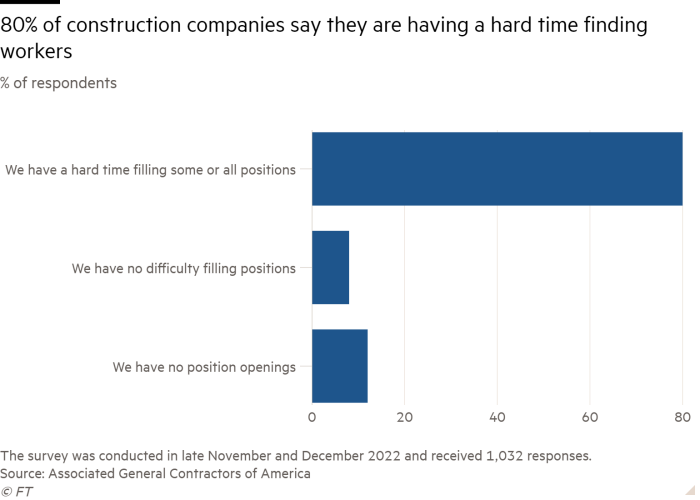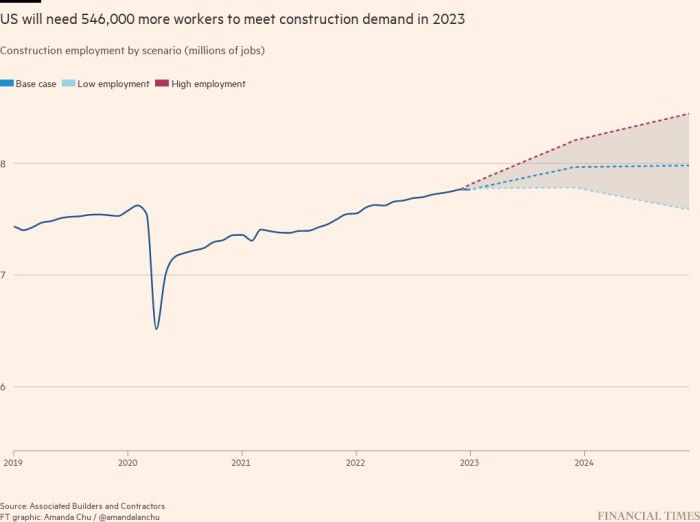A shortage of construction workers is putting at risk the Biden administration’s ambitious plan to fuel a historic building boom in the US, according to industry executives.
The construction sector could be short as many as half a million workers this year, according to the Associated Builders and Contractors, an industry group, increasing project costs and delaying a building campaign that executives say is comparable to that of the second world war.
“It would be difficult to identify a period during which the construction labour market was more constrained than it is now,” said Anirban Basu, chief economist at the ABC. “Demand for construction workers is sky high . . . This is the era of the mega project.”
President Joe Biden has signed off on spending of more than $1.5tn to boost the nation’s infrastructure and catch up with China in manufacturing. But after decades of offshoring and discouraging Americans from vocational work, construction firms warn the country’s industrial policies and the labour market are headed for a collision.
The US will need an additional 546,000 workers on top of the normal hiring pace this year to meet labour demand, estimates the ABC. Construction job openings averaged a record 391,000 in 2022, up 17 per cent from the previous year, according to the Bureau of Labor Statistics.
“We’re putting millions and millions of dollars into infrastructure without anybody to install it,” said Ed Brady, chief executive of the Home Builders Institute, a non-profit organisation that promotes construction training. “A shovel-ready project with nobody to operate the shovel is worthless.”
The federal stimulus includes $1.2tn in infrastructure spending, $369bn from the Inflation Reduction Act (IRA) for clean energy projects, and $39bn from the Chips and Science Act to spearhead the country’s production of semiconductors.
Construction unemployment sat at 4.6 per cent in 2022, the second lowest on record, according to the BLS. Hourly wages averaged $36 an hour in January, exceeding the private industry average of $33 and typical starting salaries for college graduates.
“If you compare this to almost World War II construction where the entire industry changed . . . I think we’re in a time like that,” said Bob Clark, founder of Clayco. The developer is working on more than 10 cleantech projects, including VinFast’s electric vehicle plant in North Carolina.
Despite increasing wages, 80 per cent of construction firms say they are struggling to hire workers, according to a survey by the Associated General Contractors of America last month.
In Columbus, Ohio, Intel has pledged $20bn to build two semiconductor factories, and Honda is building a $4.4bn battery plant with LG Energy Solution. The projects will require nearly 10,000 construction workers.
“The entire state of Ohio does not have the number of professionals to perform this alone,” said Catherine Hunt Ryan, manufacturing and technology president of Bechtel, one of the companies building Intel’s factories.
Bechtel said it will pull some of the 7,000 workers it needs from across the country and is in conversation with hotels for temporary housing. A middle-ranking labourer at the site could make as much as $40 per hour.
“The reshoring of manufacturing to the United States is creating a huge demand for construction workers in what was and continues to be an already tight labour market,” said Jim Brownrigg, senior vice-president at Turner Construction, the group working on the Honda-LG venture. Brownrigg said its demand for clean tech construction projects has more than quadrupled since last year.
“[Labor shortages] continue to be a bigger challenge. I think 2023 is going to be challenging. [Next year] could even be bigger,” he said. Brownrigg added that the company is investing in off-site construction and workforce development programmes and pulling workers from elsewhere to alleviate labour shortages.
Biden has made workers’ rights central to his industrial agenda and has repeatedly talked of “good-paying union jobs”. Some tax credits in the IRA and Chips act require companies to meet prevailing wage and apprenticeship requirements.
But construction bosses say the criteria present another headwind by further narrowing the labour pool. There were nearly 200,000 registered construction apprentices in 2021, according to the Department of Labor.

“The administration is effectively tying one hand behind one’s back because of the regulatory restrictions on who can engage productively in these construction projects,” Basu said.
Climate and labour groups, meanwhile, argue these requirements are necessary to create a sustainable workforce and galvanise support for climate policy.
“When work is paid, it draws more workers into the pool,” said Jessie Hammerling, co-director of the green economy program at UC Berkeley’s labour centre.
The Department of Labor said it was “urgently” trying to meet the demand for workers, adding that the administration has invested more than $330mn in apprenticeships.
To meet labour demand, construction bosses are pushing for immigration reform, an issue unlikely to gain traction in a divided Washington.
The proposed reforms include creating a temporary guest worker programme or simplifying and expanding caps on H-2B visas. More than 400,000 people have submitted applications for visas but are awaiting interviews, according to the most recent data from the state department.
One problem, according to Brian Turmail, a spokesperson for the AGC, is a contradictory attitude towards building jobs in the US.
“We just don’t want our own children to work in construction and we don’t want anyone from outside of the country to work in construction.”


